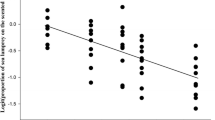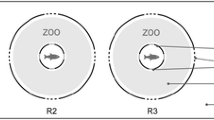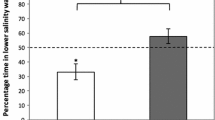Abstract
The hypothesis that low pH modifies the response of salmonids to certain olfactory stimuli was tested. An interactive video-computer system was used to monitor the behavior of juvenile Atlantic salmon (Salmo salar). At a pH of 7.6, animals were attracted to glycine and avoidedl-alanine. These effects were dose-dependent, with a threshold of 10−7 M. The response of the fish to both amino acids changed when the pH of the test chamber was gradually lowered from 7.6 to 5.1; they became attracted tol-alanine and indifferent to glycine. These effects were reversible with a return to pH 7.6. Our findings suggest that acid rain may contribute to reductions in salmonid populations in acidified rivers by impairing the recognition of olfactory cues by salmon during their spawning migration.
Similar content being viewed by others
References
Allison, P., andDorsett, D.A. 1977. Behavioral studies on chemoreception inBalanus hameri.Mar. Behav. Physiol. 4:205–217.
Atema, J., Jacobson, S., Todd, J., andBaylen, D. 1973. The importance of chemical signals in stimulating behavior of marine organisms: Effects of altered environmental chemistry on animal communications, pp. 177–179,in G.E. Glass (ed.). Bioassay Techniques and Environmental Chemistry. Ann Arbor Science Publications, Ann Arbor, Michigan.
Atema, J., Holland, K., andIkehara, W. 1980. Olfactory responses of yellowfin tuna (Thunnus albacares) to prey odors: Chemical search image.J. Chem. Ecol. 6(2):457–465.
Bodznick, D.J. 1978. Calcium ion-odorant for natural water discriminations and the migratory behavior of sockeye salmon.J. Comp. Physiol. 127A:157–166.
Brown, S.B., Evans, E., Thompson, B.E., andHara, T.J. 1982. Chemoreception and aquatic pollutants, pp. 363–394,in T.J. Hara (ed.) Chemoreception in Fish. Elsevier, Amsterdam.
Caprio, J. 1977. Electrophysiological distinction between taste and smell of amino acids in catfish.Nature 266:850–851.
Daye, P.G., andGarside, E.T. 1977. Lower lethal levels of pH for embryos and alevins of Atlantic salmon (Salmo salar).Can. J. Zool. 55:1504–1508.
Daye, P.G., andGarside, E.T. 1980. Structural alterations in embryos and alevins of Atlantic salmon (Salmo salar) induced by continuous or short-term exposure to acidic levels of pH.Can. J. Zool. 58:27–43.
Derby, C.J., andAtema, J.K. 1978. Responses of lobster walking leg chemoreceptors: The role of amino acids, proteins, and live prey body odors as feeding stimuli.Biol. Bull. (Woods Hole, Mass.) 155:433–450.
Doving, K.B., Selset, R., andThommesen, G. 1980. Olfactory sensitivity to bile acids in salmonid fishes.Acta Physiol. Scand. 108:123–131.
Fritz, E.S. 1980. Potential impacts of low pH on fish and fish populations. USFWS, Biological Service Program, National Powerplant Team Air Pollution and Acid Rain Report No. 2. FWS/ OBS-80/40.2 14 pp.
Fuzessery, Z.M., andChildress, J.J. 1975. Comparative chemosensitivity to amino acids and their role in the feeding activity of both pelagic and littoral crustaceans.Biol. Bull. (Woods Hole, Mass.) 149:522–538.
Goh, Y., andTamura, T. 1980. Effect of amino acid on the feeding behavior in red sea bream.Comp. Biochem. Physiol. 66C:225–229.
Goh, Y., Tamura, T., andKobyashi, H. 1979. Olfactory responses to amino acids in marine teleosts.Comp. Biochem. Physiol. 62A:863–868.
Greer, G.L., andKasokoski, G.J. 1978. Avoidance of seawater dilution of kraft pulp mill effluent by seawater acclimated pink salmon fry.Fish. Mar. Ser. Tech. Rep. 831, 11 pp.
Groves, A.B., Collins, G.B., andTrefethen, P.S. 1968. The role of olfaction and vision in choice of spawning site by homing adult chinook salmon (Oncorhynchus tschawytcha).J. Fish. Res. Board Can. 25:867–876.
Haines, T. 1981. Acid precipitation and its consequences for aquatic ecosystems: A review.Trans. Am. Fish. Soc. 110:669–707.
Hara, T.J. 1973. Olfactory responses to amino acids in rainbow trout.Comp. Biochem. Physiol. 44A:407–416.
Hara, T.J. 1976a. Structure-activity relationship of amino acids in fish olfaction.Comp. Biochem. Physiol. 54A:31–36.
Hara, T.J. 1976b. Effects of pH on the olfactory response to amino acids in rainbow trout (Salmo gardineri).Comp. Biochem. Physiol. 54A:37–39.
Hara, T.J. (ed.). 1982. Chemoreception in Fish. Elsevier, Amsterdam, 433 pp.
Hara, T.J., Law, Y.M.C., andHobden, B.B. 1973. Comparison olfactory response to amino acids in rainbow trout, brook trout, and whitefish.Comp. Biochem. Physiol. 45A:969–977.
Hasler, A.D. 1957. The sense organ; olfactory and gustatory sense of fish, pp. 187–209,in M. E. Brown (ed) Physiology of Fish. Academic Press, New York.
Hasler, A.D. 1960a. Guideposts of migrating fish.Science 132:785–792.
Hasler, A.D. 1960b. Perception of pathways by fish in migration, pp. 451–467,in Perspectives in Marine Biology. University of California Press, Berkeley.
Hoese, H.D., andHoese, D. 1967. Studies on the biology of the feeding reaction inGobiosome bosci.Tulane Stud. Zool. 14:55–62.
Idler, D.E., Fagerland, U.H.M., andMayoh, H. 1956. Olfactory perception in migrating salmon. I.l-Serine, a salmon repellent in mammalian skin.J. Gen. Physiol. 39:889–892.
Idler, D.E., McBride, J.R., Jonas, R.E.E., andTomlinson, N. 1961. Olfactory perception in migrating salmon. II. Studies on a laboratory bioassay for home-stream water and mammalian repellent.Can. J. Biochem. Physiol. 39:1575–1584.
Leivestad, H.,Hendrey, G.,Muniz, I.P., andSnekvik, P. 1976. Effects of acid precipitation on freshwater organisms, pp. 86–111,in F.H. Braekke (ed.). Impact of Acid Precipitation on Forests and Freshwater Ecosystems in Norway. SNSF Project FR 6/76. (Oslo, Norway).
Lehninger, A.L. 1982. Principles of Biochemistry. Worth Publications, New York, pp. 95–120.
Mackie, A.M., andShelton, R.G.J. 1972. A whole animal bioassay for the determination of the food attractants of the lobster (Homerus gammarus).Mar. Biol. 14:217–221.
McDonald, D.G. 1983. The interaction of environmental calcium and low pH on the physiology of the rainbow trout (Salmo gairdneri). I. Branchial and renal net ion and H+ fluxes.J. Exp. Biol. 102:123–140.
McDonald, D.G., Walker, R.L., andWilkes, P.R.H. 1983. The interaction of calcium and low pH on the physiology of rainbow trout (Salmo gairdneri). II. Branchial ionoregulatory mechanisms.J. Exp. Biol. 102:141–155.
McLeese, D.W. 1973. Orientation of lobsters to odors.J. Fish. Res. Board Can. 30:838–840.
Muniz, I.D. 1981. Acidification and the Norwegian salmon, pp. 65–72,in Acid Rain and the Atlantic Salmon, Proceedings of Conference, November 1980. Ed. Lee Sochasky. Published by “The International Atlantic Salmon Foundation” New York, New York.
Neville, C.M. 1979a. Sublethal effects of environmental acidification on the rainbow trout (Salmo gairdneri).J. Fish. Res. Board Can. 36:84–87.
Neville, C.M. 1979b. Influence of mild hypercapnia on the effect of environmental acidification on the rainbow trout (Salmo gairdneri).J. Exp. Biol. 83:345–349.
Royce-Malmgren, C.H., andWatson, W.H. 1986. An interactive video-computer tracking system for quantification of locomotor behavior.J. Chem. Ecol. In press.
Saunders, R.L., andSprague, J.B. 1967. Effects of copper-zinc mining pollution on a spawning migration of Atlantic salmon.Water Res. 1:419–432.
Schofield, C.L. 1980. Acid rain and the Adirondack trout, pp. 13–16, 93–97.in Acid Rain and the Atlantic Salmon, Proceedings of Conference, November 1980. Ed. Lee Sochasky. Published by “The International Atlantic Salmon Foundation” New York, New York.
Stabell, O.B. 1982. Homing of Atlantic salmon in relation to olfaction and genetics, pp. 238–246,in Proceedings of Trout Migration Behavioral Symposium.
Stabell, O.B. 1984. Homing and olfaction in salmonids: A critical review with special reference to Atlantic salmon.Biol. Rev. 59:333–388.
Sutterlin, A.M. 1974. Pollutants and the chemical senses of aquatic animals, perspective review.Chem. Senses Flavor 1:167–178.
Sutterlin, A.M., andSutterlin, N. 1971. Electrical responses of the olfactory epithelium of Atlantic salmon (Salmo salar).J. Fish. Res. Board Can. 28:565–572.
Ueda, K., Hara, T.J., andGorbman, A. 1967. Electroencephalographic studies on olfactory discrimination in adult spawning salmon.Comp. Biochem. Physiol. 21:133–143.
Watt, W.D. 1981. Present and potential effects of acid precipitation on the Atlantic salmon in eastern Canada, pp. 39–46,in Acid Rain and the Atlantic Salmon, Proceedings of Conference, November 1980. Ed. Lee Sochasky. Published by “The International Atlantic Salmon Foundation” New York, New York.
Watt, W.D., Scott, C.D., andWhite, W.J. 1983. Evidence of acidification of some Nova Scotian rivers and its impact on Atlantic salmon (Salmo salar).Can. J. Fish. Aquat. Sci. 40(4):462–473.
Wright, R., Dale, T., Gjessing, E., Hendrey, G., Henrickson, A., Johannesen, M., andMuniz, I. 1975. Impact of acid precipitation on freshwater ecosystems in Norway.Water Air Soil Pollut. 6:483–499.
Author information
Authors and Affiliations
Rights and permissions
About this article
Cite this article
Royce-Malmgren, C.H., Watson, W.H. Modification of olfactory-related behavior in juvenile Atlantic salmon by changes in pH. J Chem Ecol 13, 533–546 (1987). https://doi.org/10.1007/BF01880097
Received:
Accepted:
Issue Date:
DOI: https://doi.org/10.1007/BF01880097




